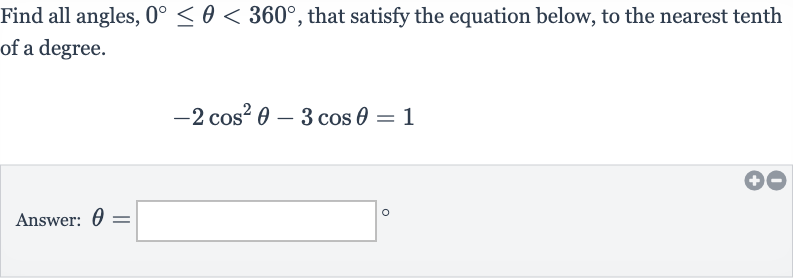Full solution
Q. Find all angles, , that satisfy the equation below, to the nearest tenth of a degree.Answer:
- Rewrite Equation with Variable: Let's first rewrite the equation in a more standard quadratic form by substituting with a variable, let's say ''. So, we have .
- Set Equation to Zero: To solve for 'x', we need to set the equation to zero. So, we add to both sides of the equation to get .
- Solve Quadratic Equation: Now, we need to solve the quadratic equation . We can use the quadratic formula, , where , , and .
- Calculate Discriminant: First, we calculate the discriminant, which is . Plugging in the values, we get .
- Find First Solution: Now, we can find the two solutions for 'x' using the quadratic formula. The first solution is .
- Find Second Solution: The second solution for 'x' is .
- Check Validity of Solutions: We need to check if these solutions for 'x' are within the range of the cosine function, which is between and . Let's calculate the numerical values: and .
- Calculate Angle for : Calculating the values, we get (which is not possible since the range of cosine is between and ) and .
- Find Second Angle: Since is not within the range of cosine, we discard it. Now, we need to find the angles for which . We will use the inverse cosine function to find these angles.
- Final Angles: Using a calculator, we find that gives us the principal value of , which is approximately degrees.
- Final Angles: Using a calculator, we find that gives us the principal value of , which is approximately degrees.However, since the cosine function is positive in both the first and fourth quadrants, we need to find the second angle by subtracting the principal value from degrees. So, degrees.
- Final Angles: Using a calculator, we find that gives us the principal value of , which is approximately degrees. However, since the cosine function is positive in both the first and fourth quadrants, we need to find the second angle by subtracting the principal value from degrees. So, degrees. We now have two angles that satisfy the original equation: degrees and degrees. These are the angles between and degrees that satisfy the equation .

